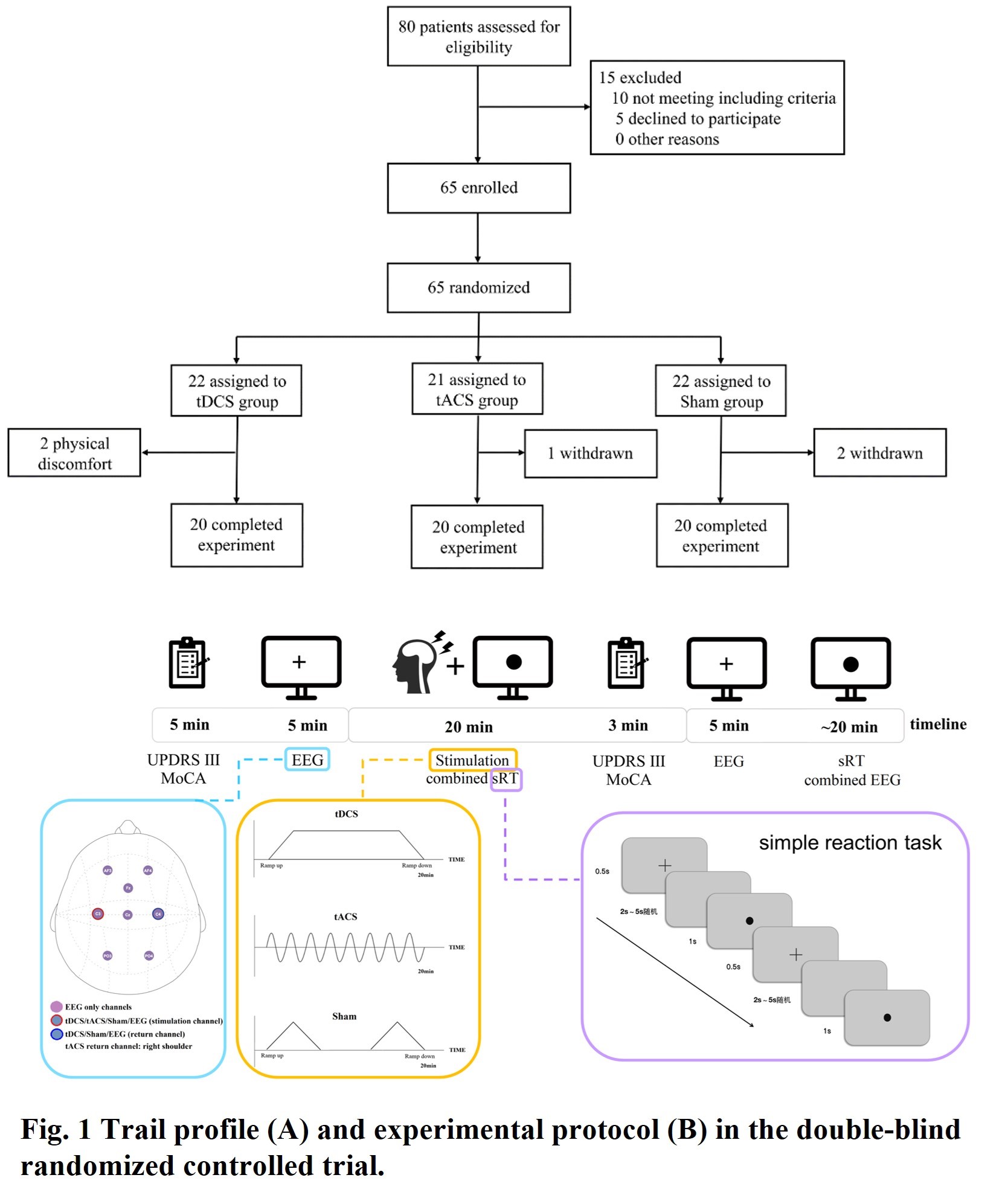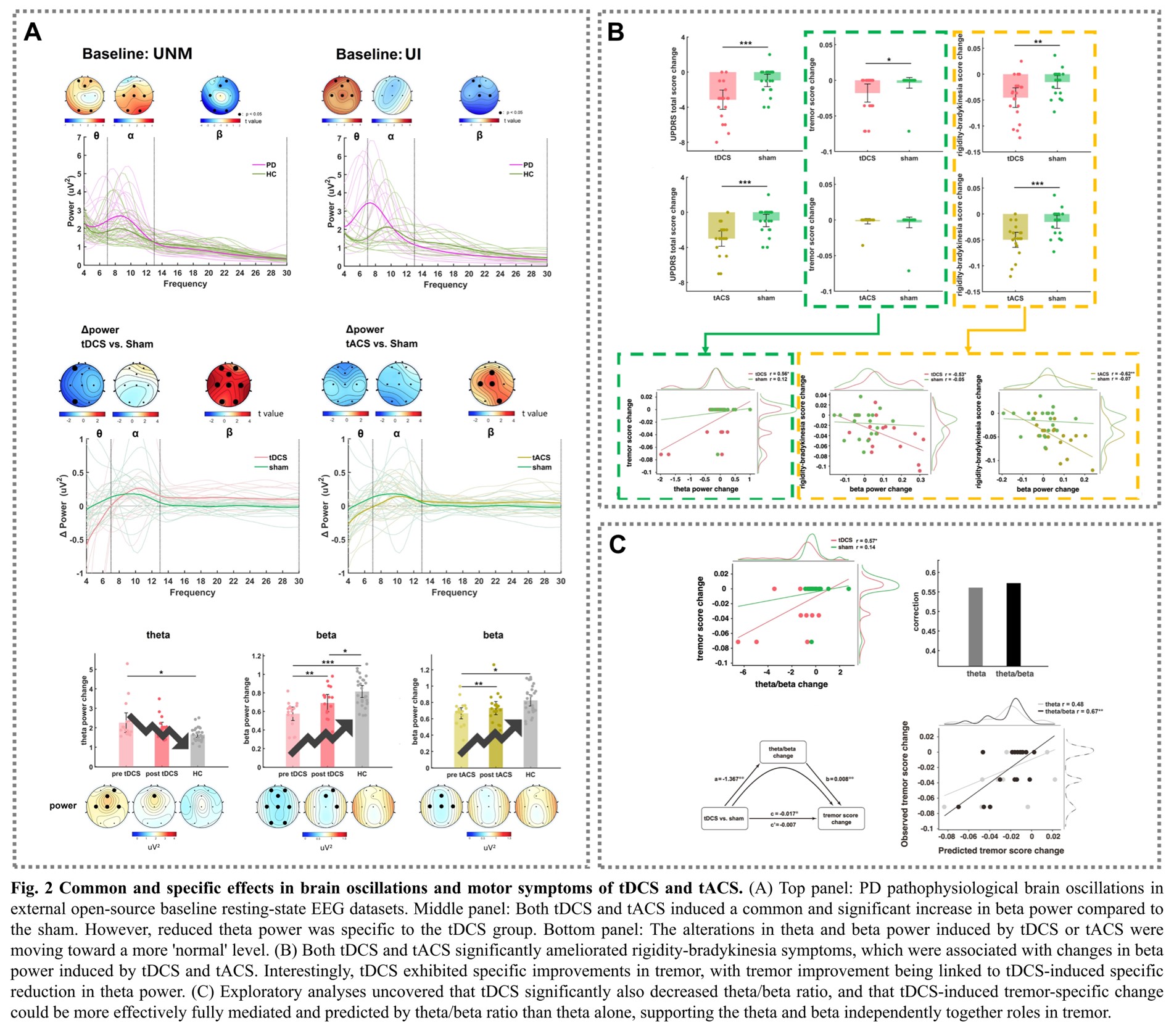Category: Parkinson’s Disease: Clinical Trials
Objective: We conducted the first randomized controlled trial (RCT) to compare the modulation of Parkinson’s disease (PD) patients by tDCS and tACS.
Background: PD entails neurodegeneration with abnormal neural oscillations causing motor phenotypes[1]. Transcranial stimulation (tDCS/tACS) offers non-invasive modulation, showing promise in symptom alleviation[2]. Yet, it is unclear whether tDCS and tACS improve motor symptoms in PD patients through a consistent oscillatory modulation mechanism.
Method: We analyzed 41 PD patients and 41 healthy controls from two external open-source datasets to observe brain oscillations in PD patients. Subsequently, a double-blind RCT (NCT05678725) was conducted. 60 PD patients were randomly assigned to tDCS, beta tACS (20Hz), or sham groups(Fig. 1A), stimulating the left primary motor cortex. A 15-minute simple reaction task assessed motor function during and after stimulation. Five minutes eyes-open resting-state EEG, UPDRS III, and MoCA measured brain oscillations, motor functions, and cognitive function, respectively(Fig. 1B).
Results: In external datasets, PD patients showed abnormal cortical oscillations compared to HC, with increased theta and decreased beta power(Fig. 2A Top panel). In the RCT, both tDCS and tACS increased beta power significantly, while tDCS specifically reduced theta power. These changes moved oscillations toward a ‘normal’ level(Fig. 2A Bottom panel). Motor symptom improvement in rigidity-bradykinesia in both tDCS and tACS groups is linked to beta power increase. The specific tremor improvement in the tDCS group is linked to theta power reduction(Fig. 2B). The exploratory analysis showed that tDCS reduced the theta/beta ratio significantly, better mediating and predicting tremor-specific changes induced by tDCS than theta alone, thus supporting the independent together roles of theta and beta in tremors(Fig. 2C).
Conclusion: This pioneering RCT compares cortical oscillation changes and symptom improvements from tDCS and tACS in PD patients, revealing both shared and distinct effects. tDCS broadly modulates oscillations, benefiting multiple symptoms, while tACS targets single oscillations for specific symptom impact. These results clarify diverse oscillatory mechanisms in PD symptom improvement, emphasizing aberrant oscillations’ crucial role in tremor and rigidity-bradykinesia pathophysiology.
Fig. 1
Fig. 2
References: 1. Wirdefeldt, K., et al., Epidemiology and etiology of Parkinson’s disease: a review of the evidence. Eur J Epidemiol, 2011. 26 Suppl 1: p. S1-58.
2. Goodwill, A.M., et al., Using non-invasive transcranial stimulation to improve motor and cognitive function in Parkinson’s disease: a systematic review and meta-analysis. Sci Rep, 2017. 7(1): p. 14840.
To cite this abstract in AMA style:
JJ. Bu, JF. Liu, H. Wan, C. Jin. Common and specific immediate effects in brain oscillations and motor symptoms of tDCS and tACS in Parkinson’s disease: A randomized controlled trial [abstract]. Mov Disord. 2024; 39 (suppl 1). https://www.mdsabstracts.org/abstract/common-and-specific-immediate-effects-in-brain-oscillations-and-motor-symptoms-of-tdcs-and-tacs-in-parkinsons-disease-a-randomized-controlled-trial/. Accessed December 16, 2025.« Back to 2024 International Congress
MDS Abstracts - https://www.mdsabstracts.org/abstract/common-and-specific-immediate-effects-in-brain-oscillations-and-motor-symptoms-of-tdcs-and-tacs-in-parkinsons-disease-a-randomized-controlled-trial/


